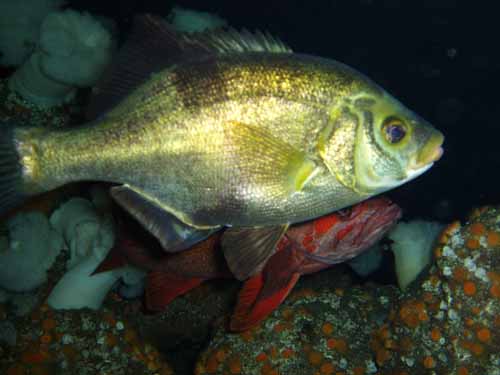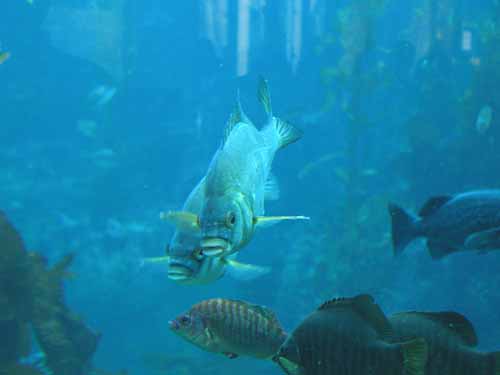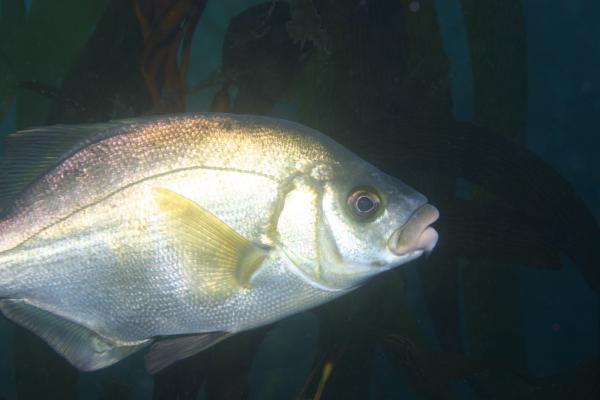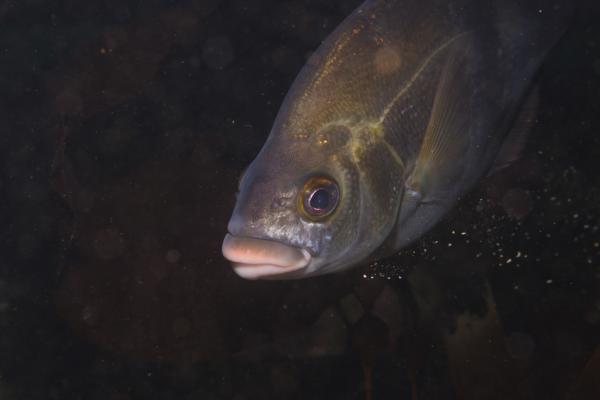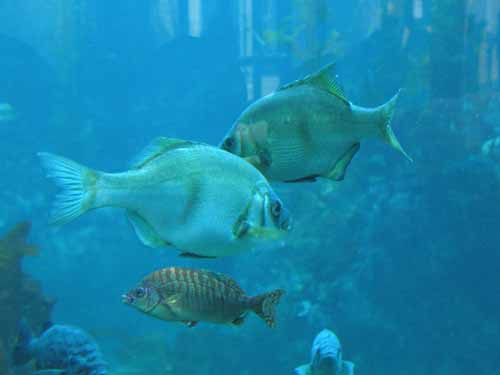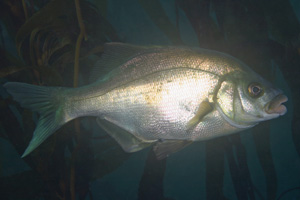
Rubberlip seaperch
Rhacochilus toxotes
Overview
Key Features:
Big perch with large dirty white or faint pink lips and tail fin that is not as deeply forked as the pile perch.
Similar Species:
Pile surfperch (Rhacochilus vacca)Primary Common Name:
Rubberlip seaperchSynonymous name(s):
Damalichthys toxotesGeneral Grouping:
Bony fishesGeographic Range:
Northern California to southern Baja California, Mexico.
Mendocino county in northern California to Cabo Thurloe, southern Baja California, Mexico.
Intertidal Height:
to feet ( to meters)Subtidal Depth Range:
Minimum Depth: 0 meters or 0 feetMaximum Depth: 50 meters or 164 feet
Habitats:
bay (rocky shore), exposed rocky shore, kelp forest, protected rocky shoreNotes:
Rhacochilus toxotes occupy the surf zone to 50 m deep, preferring rocky areas with a dense amount of aquatic vegetation and an abundance of prey.
Abundance:
Relative Abundance:
Uncommon
Species Description:
General:
Like all of the perch (Family Embiotocidae), Rhacochilus toxotes is laterally compressed (i.e. flattened side-by-side), but also has a forked tail. They are the largest among all species of surfperches. Very similar to its congener, R. vacca (pile perch), but R. toxotes has very large, fleshy lips, hence the common name of rubberlip perch.
Distinctive Features:
Large, laterally compressed perch with silver to green-gray coloration on the body, large scales and an obvious lateral line. A black bar (sometimes obvious but more often it is faint) extends below the middle of the dorsal fin to almost the front of the anal fin. Pectoral fins are usually similar in color to body, but can be yellowish or gray. Most striking are the protruding, thick lips that are usually lighter than the body, and can be dirty white or pink, with a dusting of black on the top of the upper lip, like a moustache.
Size:
Maximum length of 18.5 inches (46.99cm), the largest of surfperches.
Natural History:
General:
Rhacochilus toxotes is a part of the family Embiotocidae, which includes 23 species of surf or sea perch and grows the largest. Embiotocids like Rhacochilus toxotes are viviparous fish, which means that live young are born after being developed within the fish. Females are fertilized internally and young are born in the summer months during times of dense algal growth. They often use kelp as cover and hide with other perches such as pile and striped perch. Rhacochilus toxotes are caught from piers and jetties and can also be found schooling with pile perch
Predator(s):
Predators may include kelp bass, rockfishes, lingcod, or birds such as osprey. They are also caught by anglers on piers and jetties.
Prey:
Prey consumed include small shrimp, amphipods, crabs or mollusks.
Feeding Behavior:
CarnivoreNotes:
Rhacochilus toxotes are known to feed at night, mostly eating small thin shelled invertebrates including shrimp and crabs and mollusks.
References
Payten, Mary, Roberts W, Edgar III, G, Mike, B, Walt, Bloom Roger. “Rubberlip Seaperch.” California Finfish and Shellfish Identification Book, California Dept Fish and Wildlife, p. 96.
Gilbert, Carter Rowell., and James David. Williams. National Audubon Society Field Guide to Fishes. Alfred A. Knopf, 2002. P 463
Froese, R. and Valdestamon, R. Rei . “Rhacochilus toxotes Summary Page.” FishBase,
https://www.fishbase.se/summary/3639. Accessed(6/7/20)
Miller, Daniel J., Love S. Milton, Passa Relli K. J. Miller and Leas Guide to the Coastal Marine Fishes of California. University of California Agriculture and Natural Resources, 2020. P. 265
Related Information
Photo Library
Click on an image below to view a larger version in the SIMoN Photo Library. You will also be able to view important information on each photo such as photographer, date, caption and more
